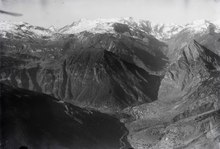Olivone
Olivone | |
|---|---|
 Olivone at the feet of Sosto (2.221 m) | |
Quinto, Vals (GR) | |
| Website | www |
Olivone was a
.On 25 January 2005, the cantonal authorities announced that Olivone would merge with Aquila, Campo Blenio, Ghirone and Torre to form a new municipality to be called Blenio. This union was carried through on 22 October 2006.[1]
History

Olivone is first mentioned in 1193 as Alivoni, then in 1205 it was mentioned as Orivono. In Romansh it was known as Luorscha.[2]
The political power in the upper Blenio valley was in the hands of a branch of the De Torre family. They owned land in Olivone and possessed the patronage rights in the
During the
On Lukmanier street the hospice of SS Sepolcro e Barnaba at Casaccia, was built in 1104. This was followed by the Hospice of S. Defendente in Camperio, built in 1254. The noble families of da Torre and da Lodrino probably founded these two hospices. They were later managed by the neighborhood and had until the 15th century, were of major social and economic importance.
Much of the local economy was based on agriculture (dairy farming and livestock). However, between the 15th century and the 19th century, much of the economy depended on money sent back home from emigrants to Italy, France and England as well as other cities in Switzerland.[2] The chocolate makers from Olivone enjoyed a good reputation in Italy and France starting in the 17th century. In the last decades of the 19th century, tourism became important. In the 20th century, tourism grew in importance and initiatives for nature and heritage protection were further promoted. At the beginning of the 21st century the village was known for its winter and summer tourism. Olivone retained its agricultural character, but in 1956 it became home to the Blenio Kraftwerke AG power plant and certain construction companies. It houses the Alpine Institute of Chemistry and Toxicology (2006) of the Alpine Foundation for Life Sciences. In 2005, 22% of jobs in Olivone were in agriculture.[2]
Historic population
The historical population is given in the following table:
| Year | Population Olivone[2] |
|---|---|
| 1567 | 593 |
| 1602 | 1,000 |
| 1682 | 1,018 |
| 1745 | 734 |
| 1785 | 640 |
| 1801 | 644 |
| 1850 | 758 |
| 1900 | 765 |
| 1950 | 707 |
| 1960 | 930 |
| 2000 | 845 |
References
External links
- Official website (in Italian)



